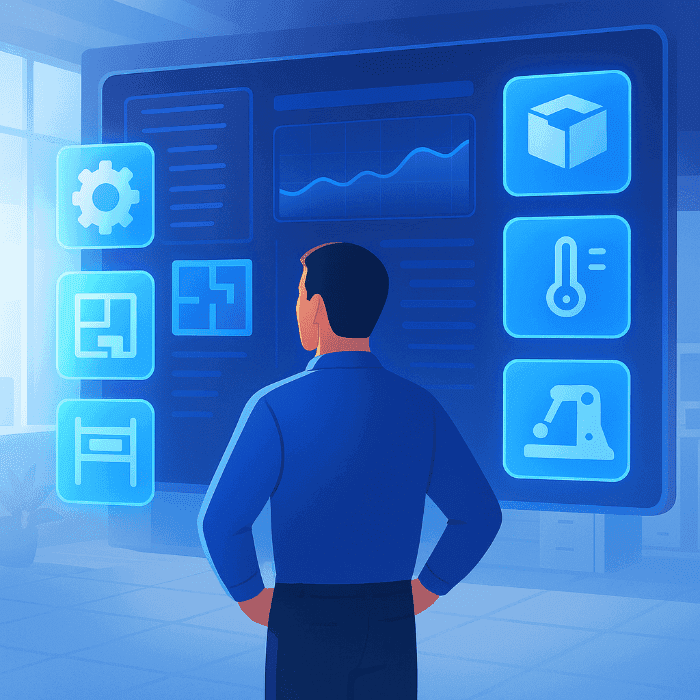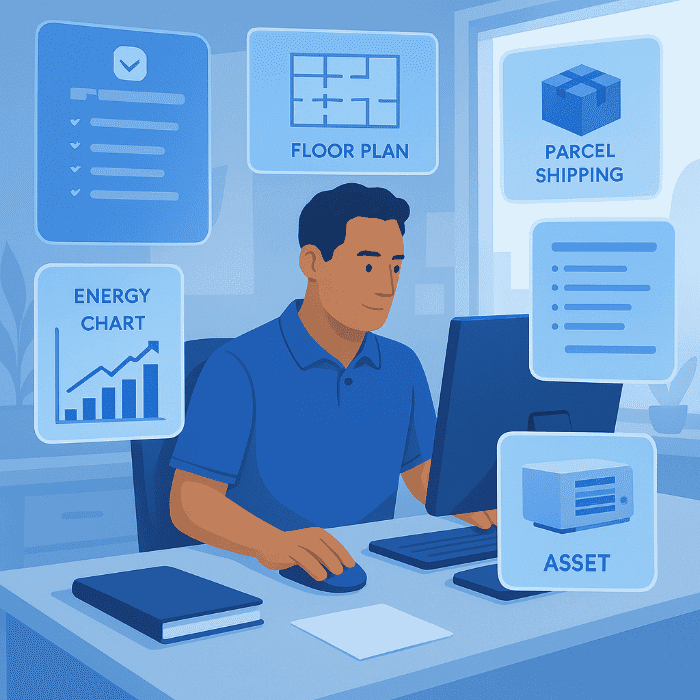Introduction: Why the Right Tools Matter in Facility Management
Facility managers juggle a wide array of responsibilities. With so much on the line, the right tools can mean the difference between smooth operations and constant firefighting. The best facility manager tools provide centralized visibility into work orders, assets, space usage, and even incoming packages, so teams can plan ahead instead of reacting at the last minute.
In this guide, we’ll explore six essential categories of facility manager tools, from maintenance and space management to parcel logistics, and show how each one helps reduce administrative load and free up time for what really matters: keeping facilities efficient, compliant, and proactive.
The 6 Types of Facility Manager Tools You Should Know
Today’s facility teams rely on specialized enterprise facility management software and apps to track tasks, assets, and spaces. Here are six core tool categories every facility manager should know:
- Computerized Maintenance Management Systems (CMMS)
- Space Management Software
- Building Automation Systems (BAS/BMS)
- Parcel Management Tools (Cost Visibility/Parcel Shipping Control)
- Inventory Management Systems
- Asset Management Systems
Each of these addresses a specific aspect of facilities operations. Below, we’ll explain what each tool does, why it’s useful, and highlight leading solutions in that category.
Tool #1: Computerized Maintenance Management Systems (CMMS)
A CMMS is software designed to help facility and maintenance teams plan, track, and execute repair and upkeep tasks. In other words, it automates many of the administrative tasks associated with maintenance work.
By centralizing maintenance data, a CMMS enables staff to quickly identify which equipment needs servicing, when it was last repaired, and who is responsible.
Use Cases and Benefits of a CMMS
Common ways facilities use a CMMS include:
- Preventive Maintenance Scheduling: Automate recurring inspections and repairs.
- Work Order Tracking: Assign and monitor maintenance tasks in real time.
- Inventory control: A CMMS updates stock and reorder alerts to keep facilities maintenance supplies available.
- Asset history and analytics: It tracks every repair and cost, helping managers decide when to service or replace facility equipment.
- Safety and compliance documentation: The system stores inspection logs and manuals, making audits and facility management projects easier to manage.
Leading CMMS Platforms
Some of the well-known CMMS solutions include UpKeep, Fiix, MaintainX, eMaint, and Limble, among others. (Large enterprises might also use broader Enterprise Asset Management (EAM) suites like IBM Maximo or Oracle.)
In industry rankings, the top CMMS platforms earn high marks for mobile access, ease of use, and scalability. When choosing one, look for a system that meets your team’s needs (e.g., supports asset tagging, mobile apps, or multiple locations) and integrates with other tools you use.
Tool #2: Space Management Software
Space management software is a tool that helps organizations plan, schedule, and optimize their physical spaces (offices, classrooms, meeting rooms, labs, etc.). At its core, it tracks who’s using which space and when.
Rather than relying on spreadsheets or whiteboards, the Space Management software provides real-time occupancy data.
Use Cases and Benefits of a Space Management Software
Facilities and workplace teams leverage space tools for scenarios like:
- Schedule workspaces: Employees easily book desks, offices, or meeting rooms online, with automatic capacity and conflict control.
- Space optimization: Managers analyze usage patterns (e.g., which floors or rooms are most frequently booked) to decide if layouts should change.
- Manage moves: Interactive floor plans simplify relocations and document every layout change.
- Reporting and analytics: Space tools generate reports on occupancy rates, booking trends, and space allocation, enabling data-driven planning for real estate and headcount.
Popular Space Management Apps
There are many options for space management. Commercial offerings include Robin, Planon, Office Space, Envoy, YAROOMS, and Kadence, among others. Each varies in features (some focus on desk and room booking, others on occupancy analytics or facility-wide planning).
When evaluating, look for solutions with interactive floor plans, mobile access, and integration with calendar and directory systems. Ultimately, the best space management app will give your facility team insights into space utilization and let them adjust assignments on the fly.
Tool #3: Building Automation Systems (BAS/BMS)
A Building Automation System (BAS), also called Building Management System (BMS), is an integrated control system for a facility’s mechanical and electrical equipment. In practice, a BAS connects devices like HVAC (heating, ventilation, air conditioning), lighting, and sometimes security or energy meters, allowing centralized monitoring and control.
Use Cases and Benefits of a Building Automation System
Typical BAS use cases include:
- Energy management and savings: Continuously monitors and adjusts HVAC and lighting to reduce energy use and lower utility bills by 10–30%.
- Comfort and air quality: Maintains ideal temperature, ventilation, and humidity to improve employee comfort, productivity, and overall indoor air quality.
- Centralized monitoring and alerts: Provides a single dashboard to track all building systems and send real-time alerts for issues before they escalate.
- Scalability across buildings: Allows large organizations to manage multiple sites, standardize schedules, and enforce consistent energy policies.
Popular BAS/BMS Options
Leading BAS vendors include Siemens, Honeywell, Johnson Controls, and Schneider Electric, among others. Each system has its own hardware controllers and software interface.
When choosing a BAS, look for good compatibility with your facility’s HVAC and lighting systems, strong analytics, and user-friendly controls. Many modern BAS solutions also integrate with IoT sensors and use cloud dashboards for remote monitoring.
Tool #4: Parcel Management Software
For most facility managers, parcel shipping isn’t part of their core budget, yet it often eats up valuable time and resources. Between tracking incoming deliveries, handling outgoing shipments, and managing multiple carrier accounts, what should be a simple process quickly becomes another layer of administrative complexity.
Beyond the tracking challenge, parcel-related expenses are typically scattered across departments or credit cards, making it hard to manage or report accurately. That lack of cost visibility not only affects budgets but also takes time away from more critical work orders and maintenance priorities.
That’s where Airpals Parcel Management Platform comes in.
How Airpals Simplifies Parcel Management for Facilities Teams
Airpals is an AI-powered parcel management platform that centralizes shipping across multiple carriers and locations. Rather than replacing your carriers, Airpals integrates them into one simple dashboard that gives you complete control and transparency.
With Airpals, facility managers and logistics coordinators can:
- Gain Cost Transparency: Track real-time shipping spend across teams and locations.
- Manage Expenses: Detect and prevent overcharges or duplicate fees to improve budget accuracy.
- Boost Productivity: Reduce administrative time spent on label creation, billing, and shipment tracking by up to 80%.
- Enable Centralized Control: Assign user roles, set permissions, and establish clear policies for shipments.
- Improve Sustainability Reporting: Monitor carbon emissions and track reduction across carriers.
- Deploy Fast: Integrate with existing systems through a no-code implementation process.
Tool #5: Inventory Management Systems
An inventory management system in facilities is software that tracks all the supplies, parts, and equipment needed to run a building. This can include everything from lightbulbs and filters to safety gear and tools. These tools eliminate manual counts and reduce overstocking or shortages of facilities maintenance supplies.
Use Cases and Benefits of an Inventory Management System
In facility management, inventory systems serve for:
- Real-Time Stock Tracking: Monitor usage trends and automatically trigger restocking.
- Procurement Optimization: Prevent overbuying while ensuring critical parts are available.
- Cost Reduction: Minimize waste and storage costs through accurate forecasting.
- Compliance: Keep digital records of materials for safety and audit requirements.
Popular Inventory Management Tools
Popular solutions range from general inventory packages to those tailored for facilities. Examples include Oracle NetSuite, Oracle Katana, Fishbowl, Zoho, and simpler tools like inFlow or Sortly.
Many CMMS and ERP systems also have built-in inventory modules. When choosing a tool, ensure it supports barcode scanning for easy counting and that it can integrate with your procurement or accounting systems.
Tool #6: Asset Management Systems
An Asset Management System (often part of CMMS/EAM software) focuses on the life cycle of physical assets, from acquisition through disposal. The system records each asset’s details (model, serial number, purchase date, warranty, location, etc.) and tracks its performance and maintenance history.
Use Cases and Benefits Across the Asset Lifecycle
Implementing an asset management system delivers key benefits:
- Extended lifespan: Preventive and condition-based maintenance keeps equipment reliable longer, reducing replacement costs.
- Better performance: Well-maintained assets run more efficiently, lowering energy use and repair frequency.
- Less downtime: Predictive alerts and scheduled maintenance minimize unexpected failures and disruptions.
- Cost control: Tracking ownership and maintenance costs improves budgeting and investment planning.
- Safety and compliance: Regular inspections and digital records ensure assets meet regulations and operate safely.
Popular Asset Management Software Options
Leading asset/EAM solutions include IBM Maximo, Infor EAM, SAP Asset Management, Asset Panda, and UpKeep. Many CMMS platforms (like UpKeep) also bill themselves as asset management tools, since they track equipment.
The right choice depends on complexity: large corporations often use enterprise EAM with advanced features, while smaller sites might opt for user-friendly CMMS with asset modules.
Key Takeaways
- Maintenance and asset tracking go hand-in-hand. A robust CMMS/EAM and inventory system ensures the right parts and workers are in place to fix issues, extending the life of facility equipment and avoiding emergency repairs.
- Optimize space and resources. Space management apps help teams plan where people and activities should be, maximizing the use of real estate. Similarly, a BAS automates HVAC/lighting to boost comfort and slash energy waste.
- Automation reduces risk. Whether through BAS or CMMS systems, automated alerts and analytics help prevent breakdowns and compliance failures.
- Airpals completes the stack. While most tools cover assets, maintenance, and energy, Airpals adds parcel spend visibility, an area that often escapes financial oversight.
The Overlooked Tool Every Facility Manager Ends Up Needing
Between preventive maintenance, HVAC issues, and work orders that never stop coming, shipping parcels is rarely a top priority. Yet every week, hours get lost to tracking packages, managing multiple carrier logins, and reconciling invoices, tasks that drain time from what truly matters: keeping your facilities running smoothly.
Airpals fills that gap. As a modern parcel management platform, it brings every carrier account under one roof, giving facilities teams unified visibility into chain of custody, expense tracking, and information management.
For companies managing complex facility management projects, Airpals isn’t just another logistics tool; it automates the admin side of parcel logistics, so your team can stay proactive, not reactive.
Request a complimentary diagnostic call to uncover inefficiencies, recover hidden costs, and see how Airpals can help your team gain back hours every week.

Frequently Asked Questions (FAQs)
What are facility manager tools?
Facility manager tools are digital solutions that help teams manage assets, maintenance, inventory, energy, and logistics. They include CMMS, space management, parcel management, BAS, inventory, and asset tracking tools.
What is a common tool used for facility management?
A common facility manager tool is a Computerized Maintenance Management System (CMMS), which automates maintenance scheduling, work orders, and equipment tracking. Other popular tools include space management, building automation, and parcel management platforms.
What is the strongest tool of a facility manager?
It depends on each organization’s focus. While CMMS or automation tools manage maintenance and energy, few address logistics visibility. That’s where parcel management platforms like Airpals help facility teams control parcel shipping costs and data in one place.
Why is parcel management important in facility management?
Because unmanaged shipping across departments quickly leads to hidden costs, lost visibility, and wasted time. A parcel management platform helps facility teams centralize carrier accounts, track shipments, and control expenses across locations
How does a CMMS differ from an Asset Management System?
While CMMS helps you fix things, asset management helps you decide when to maintain, upgrade, or replace assets based on their performance and cost. In practice, many modern CMMS tools include asset management features, and vice versa.
How can Airpals benefit multi-site organizations?
Airpals gives multi-location teams unified control over parcel shipping spend, ensuring transparency and compliance while lowering time spent on administrative work.




